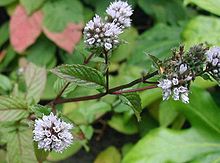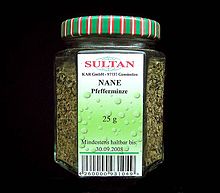- Peppermint
-
This article is about the herb. For the tree commonly known as peppermint, see Agonis flexuosa. For the Linux operating system, see Peppermint OS.
Peppermint 
Peppermint (Mentha x piperita) Scientific classification Kingdom: Plantae (unranked): Angiosperms (unranked): Eudicots (unranked): Asterids Order: Lamiales Family: Lamiaceae Genus: Mentha Binomial name Mentha × piperita
L.Peppermint (Mentha × piperita, also known as M. balsamea Willd.[1]) is a hybrid mint, a cross between the watermint (Mentha aquatica) and spearmint (Mentha spicata).[2] The plant, indigenous to Europe, is now widespread in cultivation throughout all regions of the world.[3] It is found wild occasionally with its parent species.[3][4]
Contents
Botany
Peppermint was first described in 1753 by Carolus Linnaeus from specimens that had been collected in England; he treated it as a species,[5] but it is now universally agreed to be a hybrid.[6]
It is a herbaceous rhizomatous perennial plant growing to 30–90 cm (12–35 in) tall, with smooth stems, square in cross section. The rhizomes are wide-spreading, fleshy, and bare fibrous roots. The leaves are from 4–9 cm (1.6–3.5 in) long and 1.5–4 cm (0.59–1.6 in) cm broad, dark green with reddish veins, and with an acute apex and coarsely toothed margins. The leaves and stems are usually slightly hairy. The flowers are purple, 6–8 mm (0.24–0.31 in) long, with a four-lobed corolla about 5 mm (0.20 in) diameter; they are produced in whorls (verticillasters) around the stem, forming thick, blunt spikes. Flowering is from mid to late summer. The chromosome number is variable, with 2n counts of 66, 72, 84, and 120 recorded.[4][7][8]
Ecology
Peppermint typically occurs in moist habitats, including stream sides and drainage ditches. Being a hybrid, it is usually sterile, producing no seeds and reproducing only vegetatively, spreading by its rhizomes. If placed, it can grow anywhere, with a few exceptions.[4][8]
Outside of its native range, areas where peppermint was formerly grown for oil often have an abundance of feral plants, and it is considered invasive in Australia, the Galápagos Islands, New Zealand,[9] and in the United States.[10] in the Great Lakes region, noted since 1843.[11]
Cultivation
Peppermint generally grows best in moist, shaded locations, and expands by underground stolons. Young shoots are taken from from old stocks and dibbled into the ground about 1.5 feet apart. They grow quickly and cover the ground with runners if it is permanently moist. For the home gardener, it is often grown in containers to restrict rapid spreading. It grows best with a good supply of water, without being water-logged, and planted in areas with part-sun to shade.
The leaves and flowering tops are used; they are collected as soon as the flowers begin to open and can be dried. The wild form of the plant is less suitable for this purpose, with cultivated plants having been selected for more and better oil content. They may be allowed to lie and wilt a little before distillation, or they may be taken directly to the still.
Uses
Peppermint has a long tradition of medicinal use, with archaeological evidence placing its use at least as far back as ten thousand years ago.[citation needed]
Peppermint has a high menthol content, and is often used as tea and for flavouring ice cream, confectionery, chewing gum, and toothpaste. The oil also contains menthone and menthyl esters, particularly menthyl acetate.[12] Dried peppermint typically has 0.3-0.4% of volatile oil containing menthol (29-48%), menthone (20-31%), menthyl acetate (3-10%), menthofuran (1-7%) and many trace constituents including limonene, pulegone, eucalyptol, and pinene.[13] It is the oldest and most popular flavour of mint-flavoured confectionery. Peppermint can also be found in some shampoos and soaps, which give the hair a minty scent and produce a cooling sensation on the skin. Used in this way, it has been known to help with insomnia.[citation needed]
Peppermint has promising radioprotective effects for cancer patients undergoing cancer treatment.[14]
The aroma of peppermint has been found to enhance memory.[15] As such, it can be administered by instructors to their students before examinations, to aid recall.[15]
Peppermint flowers are large nectar producers and honey bees as well as other nectar harvesting organisms forage them heavily. A mild, pleasant varietal honey can be produced if there is a sufficient area of plants.
Peppermint oil
Peppermint oil has a high concentration of natural pesticides, mainly menthone.[16]
In 2007, Italian investigators reported that 75% of the patients in their study who took peppermint oil capsules for four weeks had a major reduction in irritable bowel syndrome (IBS) symptoms, compared with just 38% of those who took a placebo.[17] A second study in 2010, conducted in Iran, found similar results.[18] 2011 research showed that peppermint acts through a specific anti-pain channel called TRPM8 to reduce pain sensing fibres. The authors feel that this study provides information that is potentially the first step in determining a new type of mainstream clinical treatment for Irritable Bowel Syndrome.[19]
Similarly, some poorly designed earlier trials found that peppermint oil has the ability to reduce colicky abdominal pain due to IBS with an NNT (number needed to treat) around 3.1,[20] but the oil is an irritant to the stomach in the quantity required and therefore needs wrapping for delayed release in the intestine. This could also be achieved by using the whole herb or leaves rather than the volatile components alone. Peppermint relaxes the gastro-esophageal sphincter, thus promoting belching.[citation needed]
Peppermint oil is also used in some Chinese medicines, such as the medicated oil Po Sum On.
Toxicology
The toxicity studies of the plant have received controversial results. Some authors reported that the plant may induce hepatic diseases (liver disease), while others found that it protects against liver damage that is caused by heavy metals.[21][22] In addition to that, the toxicities of the plant seem to vary from one cultivar to another[23] and are dose dependent.[21][24] This is probably attributed from the content level of pulegone.[25]
List of the cultivars
A number of cultivars have been selected for garden use:[7]
- Mentha × piperita 'Candymint'. Stems reddish.
- Mentha × piperita 'Citrata' (Includes a a number of varieties including Orange Mint, Eau De Cologne Mint, Grapefruit Mint). Leaves aromatic, hairless.
- Mentha × piperita 'Crispa'. Leaves wrinkled.
- Mentha × piperita 'Lime Mint'. Foliage lime-scented.
- Mentha × piperita 'Variegata'. Leaves mottled green and pale yellow.
- Mentha × piperita 'Chocolate Mint'. Flowers open from bottom up; reminiscent of flavour in Andes Chocolate Mints, a popular confection.[26]
Commercial cultivars may include
- Dulgo pole [27]
- Zefir [27]
- Bulgarian population #2 [27]
- Clone 11-6-22 [27]
- Clone 80-121-33 [27]
- Mitcham Digne 38 [28]
- Mitcham Ribecourt 19 [28]
- Todd's#x2019 [28]
Standardization of its products and services
- ISO 676:1995 - contains the information about the nomenclature of the variety and cultivars [29]
- ISO 5563:1984 - a specification for its dried leaves of Mentha piperita Linnaeus [30]
- Aromatherapy
- Candy cane
- Chewing gum
- Peppermint oil - ISO 856:2006 [31]
- Insect repellent
- Mint chocolate
- Peppermint tea
- Peppermint candy
See also
- Essential oils
- Mentha
- Mentha longifolia
- Menthol
- Pennyroyal
- Pulegone
- Spearmint (Mentha spicata)
- Spice and Condiment
Notes
- ^ WHO Monographs on Selected Medicinal Plants: Volume 2. Geneva: World Health Organization. 2002. ISBN 92-4-154537-2. http://whqlibdoc.who.int/publications/2002/9241545372.pdf. Retrieved October 29, 2010.[page needed]
- ^ The Complete Illustrated Book of Herbs, Alex Frampton, The Reader's Digest Association, 2009
- ^ a b Euro+Med Plantbase Project: Mentha × piperita
- ^ a b c Flora of NW Europe: Mentha × piperita
- ^ Linnaeus, C. (1753). Species Plantarum 2: 576–577.
- ^ Harley, R. M. (1975). Mentha L. In: Stace, C. A., ed. Hybridization and the flora of the British Isles page 387.
- ^ a b Huxley, A., ed. (1992). New RHS Dictionary of Gardening. Macmillan ISBN 0-333-47494-5.[page needed]
- ^ a b Blamey, M. & Grey-Wilson, C. (1989). Flora of Britain and Northern Europe. ISBN 0-340-40170-2[page needed]
- ^ Pacific Island Ecosystems at Risk: Mentha x piperita
- ^ USDA Plants Profile: Mentha x piperita
- ^ "List of invasive species in the Great Lakes Great Lakes United / Union Saint-Laurent Grands Lacs". http://www.glu.org/en/node/199. Retrieved 2009-02-07.
- ^ PDR for Herbal Medicines, 4th Edition, Thomson Healthcare, page 640. ISBN 978-1563636783
- ^ Leung, A. Y. (1980). Encyclopedia of Common Natural Ingredients used in food, drugs and cosmetics. New York: John Wiley & Sons. p. 231.
- ^ Baliga, M. S.; Rao, S. (2010). "Radioprotective potential of mint: A brief review". J Cancer Res Ther. 6 (3): 255–262. http://www.doaj.org/doaj?func=abstract&id=701298.
- ^ a b Moss, Mark; Hewitt, Steven; Moss, Lucy; Wesnes, Kieth (2008). "Modulation of cognitive performance and mood by aromas of peppermint and ylang-ylang". The International journal of neuroscience 118 (1): 59–77. doi:10.1080/00207450601042094. PMID 18041606. "Peppermint was found to enhance memory whereas ylang-ylang impaired it, and lengthened processing speed. In terms of subjective mood peppermint increased alertness and ylang-ylang decreased it, but significantly increased calmness"
- ^ Robert Irving Krieger (2001). Handbook of Pesticide Toxicology: Principles. Academic Press. pp. 823. ISBN 9780124262607. http://books.google.com/books?id=ib8Qhju9EQEC&pg=PA823. Retrieved 11 October 2010.
- ^ Cappello, G; Spezzaferro, M; Grossi, L; Manzoli, L; Marzio, L (2007). "Peppermint oil (Mintoil®) in the treatment of irritable bowel syndrome: A prospective double blind placebo-controlled randomized trial". Digestive and Liver Disease 39 (6): 530–6. doi:10.1016/j.dld.2007.02.006. PMID 17420159.
- ^ Merat, Shahin; Khalili, Shadi; Mostajabi, Pardise; Ghorbani, Anahita; Ansari, Reza; Malekzadeh, Reza (2010). "The effect of enteric-coated, delayed-release peppermint oil on irritable bowel syndrome". Digestive diseases and sciences 55 (5): 1385–90. doi:10.1007/s10620-009-0854-9. PMID 19507027.
- ^ "How Peppermint Helps to Relieve Irritable Bowel Syndrome". ScienceDaily. April 20, 2011. http://www.sciencedaily.com/releases/2011/04/110419101234.htm.
- ^ "Peppermint oil for irritable bowel syndrome". Bandolier. http://www.medicine.ox.ac.uk/bandolier/booth/alternat/AT022.html.
- ^ a b Akdogan, M; Ozguner, M; Aydin, G; Gokalp, O (2004). "Investigation of biochemical and histopathological effects of Mentha piperita Labiatae and Mentha spicata Labiatae on liver tissue in rats". Human & experimental toxicology 23 (1): 21–8. doi:10.1191/0960327104ht412oa. PMID 15027812.
- ^ Sharma, A; Sharma, MK; Kumar, M (2007). "Protective effect of Mentha piperita against arsenic-induced toxicity in liver of Swiss albino mice.". Basic & clinical pharmacology & toxicology 100 (4): 249–57. doi:10.1111/j.1742-7843.2006.00030.x. PMID 17371529.
- ^ Akdogan, M; Kilinç, I; Oncu, M; Karaoz, E; Delibas, N (2003). "Investigation of biochemical and histopathological effects of Mentha piperita L. and Mentha spicata L. on kidney tissue in rats". Human & experimental toxicology 22 (4): 213–9. doi:10.1191/0960327103ht332oa. PMID 12755472.
- ^ Akdogan, M; Gultekin, F; Yontem, M (2004). "Effect of Mentha piperita (Labiatae) and Mentha spicata (Labiatae) on iron absorption in rats". Toxicology and industrial health 20 (6–10): 119–22. doi:10.1191/0748233704th206oa. PMID 15941008.
- ^ Farley, Derek R.; Howland, Valerie (1980). "The natural variation of the pulegone content in various oils of peppermint". Journal of the Science of Food and Agriculture 31 (11): 1143–51. doi:10.1002/jsfa.2740311104.
- ^ Mountain Valley Growers: Mentha piperita cv. Chocolate Mint
- ^ a b c d e Stanev, S.; V.D. Zheljazkov. "Study on essential oil and free menthol accumulation in 19 cultivars, populations, and clones of peppermint (Mentha X Piperita)". http://www.actahort.org/books/629/629_21.htm. Retrieved 6 June 2009.
- ^ a b c Jullien, Frédéric; Diemer, Florence; Colson, Monique; Faure, Olivier (1998). Plant Cell, Tissue and Organ Culture 54 (3): 153–9. doi:10.1023/A:1006185103897.
- ^ International Organization for Standardization. "ISO 676:1995 Spices and condiments -- Botanical nomenclature". http://www.iso.org/iso/iso_catalogue/catalogue_tc/catalogue_detail.htm?csnumber=4844. Retrieved 8 June 2009.
- ^ International Organization for Standardization. "ISO 5563:1984 Dried peppermint (Mentha piperita Linnaeus) -- Specification". http://www.iso.org/iso/catalogue_detail.htm?csnumber=11633. Retrieved 7 June 2009.
- ^ International Organization for Standardization. "ISO 856:2008 Oil of peppermint (Mentha x piperita L.)". http://www.iso.org/iso/iso_catalogue/catalogue_tc/catalogue_detail.htm?csnumber=32041. Retrieved 7 June 2009.
External links
Categories:- Mentha
- Herbs
- Medicinal plants
- Hybrid plants
- Antiemetics
Wikimedia Foundation. 2010.



